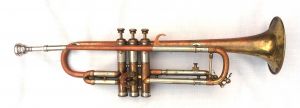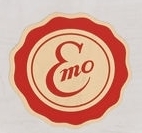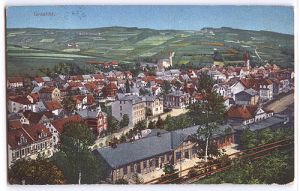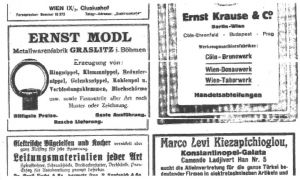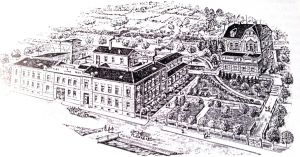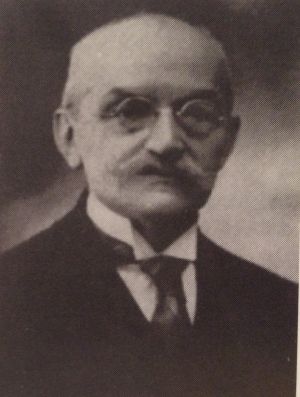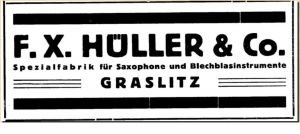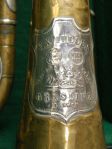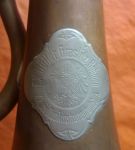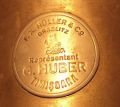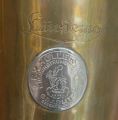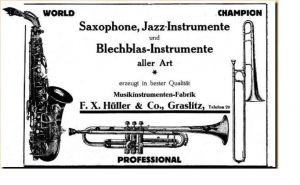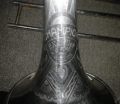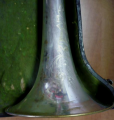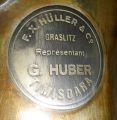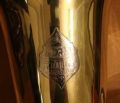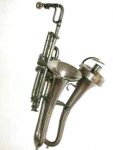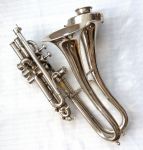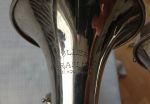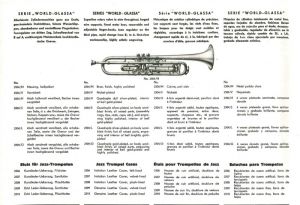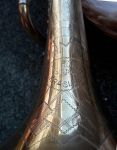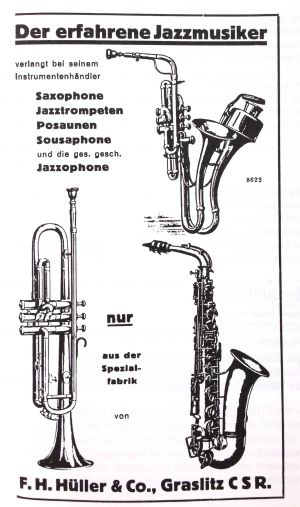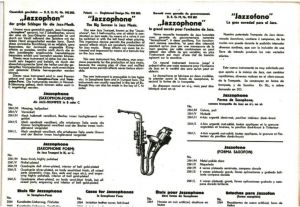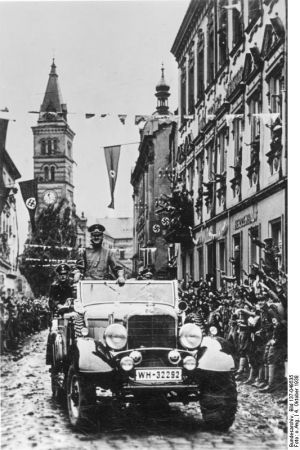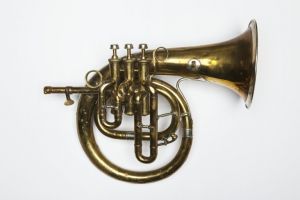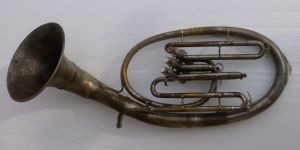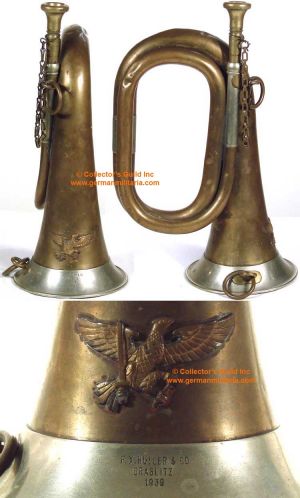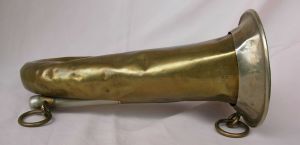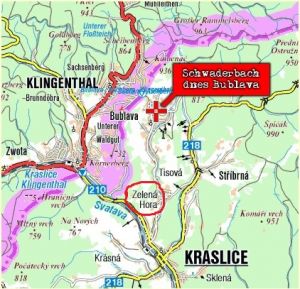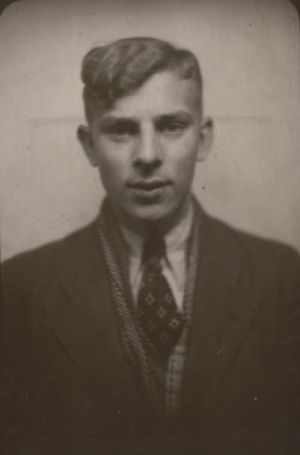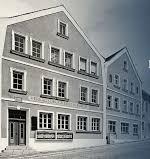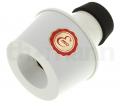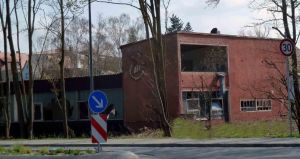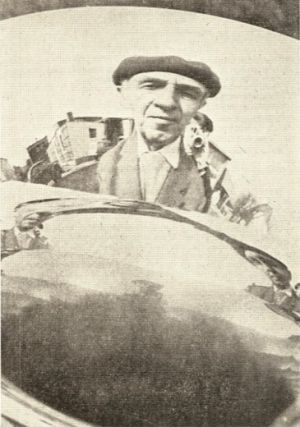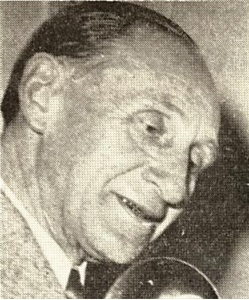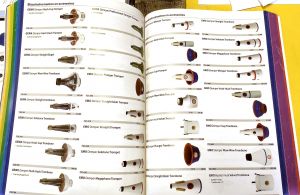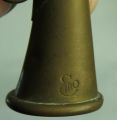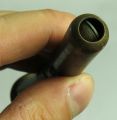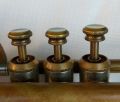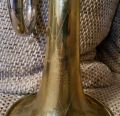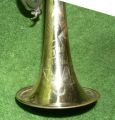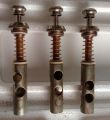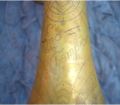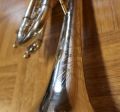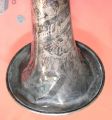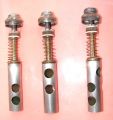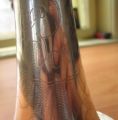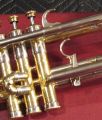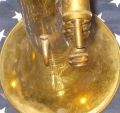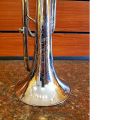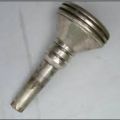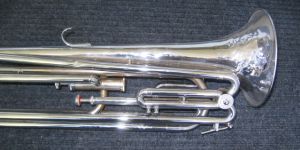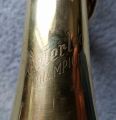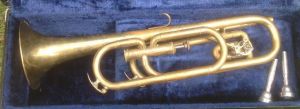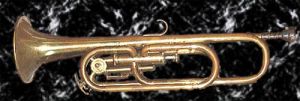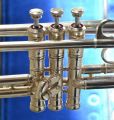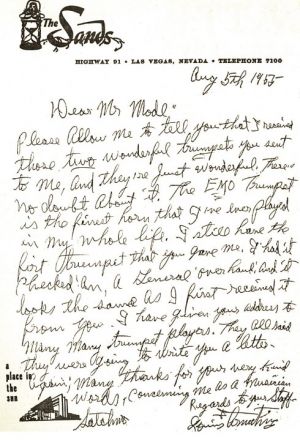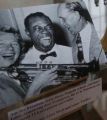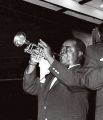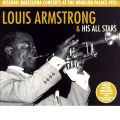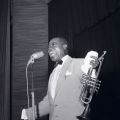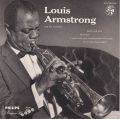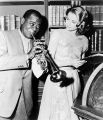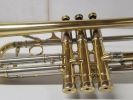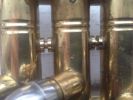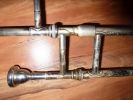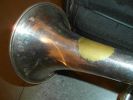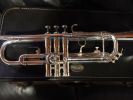Difference between revisions of "Ernst Modl brass instruments"
Gwesterhof (talk | contribs) m (→The Louis Armstrong story) |
Gwesterhof (talk | contribs) m (→The Louis Armstrong story) |
||
| Line 882: | Line 882: | ||
<gallery> | <gallery> | ||
File:Louis_Armstrong_Grace_Kelly_High_Society_1956.jpg | File:Louis_Armstrong_Grace_Kelly_High_Society_1956.jpg | ||
| + | File:Selmer_Armstrong_approx_1956_Down_Beat.jpg | ||
</gallery> | </gallery> | ||
| Line 891: | Line 892: | ||
</gallery> | </gallery> | ||
<small>Hugh Masekela with his Emo/F.X.Hüller trumpet</small> | <small>Hugh Masekela with his Emo/F.X.Hüller trumpet</small> | ||
| + | |||
| + | An article in the Smithsonian Magazine gives a little more insight in Armstrongs use of trumpets. Although Armstrong played dozens of instruments, the Smithsonian’s horn, made by Henri Selmer of Paris is among only a few to be inscribed with his name. It was ordered in 1940 by his friend and manager Joe Glaser. A correspondence from Glaser to the Selmer instrument company dated Feb. 22, 1946 noted that Armstrong had been using a Selmer trumpet manufactured in 1932 and wanted “an exact duplicate.” | ||
| + | |||
| + | Armstrong said once he went through trumpets fairly regularly. “I give my horns about five years. Of course I look after them, run hot water through the instrument every night so you know it’s going to percolate.” | ||
| + | |||
| + | “It will last forever if you keep it cleaned out, like your stomach,” Armstrong said. “So I could keep my trumpets longer, but I use a horn a lot and that’s how long I usually give ‘em.” | ||
==Ernst Modl serial number overview== | ==Ernst Modl serial number overview== | ||
Revision as of 14:01, 31 December 2020
Every now and then an Emo trumpet pops up on Ebay and other auction sites and a potential buyer asks: 'who knows more'. Little is known about it's maker Ernst Modl who's career started before WWI in Bohemia and ended after WWII in West-Germany. Often the link with Louis Armstrong is mentioned and there are these still available Emo mutes.
On this page I collected the available information. Starting with his pre WWII career in the F.X. Hüller company in Graslitz, the war years, his patents, and an overview of his instruments that appear not only under the Emo brand but also under names like Ludwig, Buffet Crampon, Rudy Muck, Smith Music Sales and Waterloo. And a list of their serial numbers. Trying to connect things and hoping for additional information to come.
Note: This page focusses on brass and on the career of Ernst Modl. More information about F.X.Hüller and their (pre war)saxophone production you can find at F.X.Hüller.com
Contents
Before WWII
The life of Ernst Modl starts on July 4th 1892 in Graslitz, Czechoslovakia. Graslitz, now known as Kraslice, is a town close to the border with Germany. It was then part of the Austro-Hungarian empire. Graslitz housed an extensive production of musical instruments, brass and woodwind, but also harmonicas. The other economic pillar was textile industry. At the beginning of the 20th century, there were 86 middle and smaller textile factories and 11 musical instrument factories in Graslitz. There were also 40 independent companies that either produced musical instruments or their components.
I'm not sure about the ancestors of Ernst Modl. There's a Josef Modl listed in 1771 as musical instrument trader, living at Modlgasse 371 (549) in Graslitz. One of his descendants was also called Josef Modl, rotary valve block maker and trader of wind and string instruments in the early 1900's at Modlgasse 542/786 in Graslitz, with his workshop founded in 1848. In 1913 Josef Modl is listed along with F.X.Hüller as one of the two Graslitz makers that participate in the newly registered O.Hebron export firm in Berlin, together with a lot of Markneukirchen based traders.
Until WWI the city was booming. In the years of the First World War, the economic boom stagnated. In 1918, Austria-Hungary, to which Graslitz belonged, disintegrated, and the Czechoslovak Republic was founded. After WWI production in Graslitz quickly recovered and at a time there were 59 musical instrument manufacturers in the area including such names as Bohland & Fuchs, F.X.Hüller, A.K. Hüttl and Julius Keilwerth.
Ernst Modl Metallwarenfabrik
From ca. 1918 till 10-05-1920 Ernst Modl is listed as maker of rotary valve blocks (G.Dullat). In the catalog '400 Jahre Musikinstrumentenbau in Graslitz' Dullat also mentions Josef Modl at Modlgasse 542 (786), and he states that it's the same as Ernst Modl at Modlgasse 786, who's listed as 'Maschinen- und Metalblassinstrumentenbau sowie Herstellung von Geschossteilen". That could mean that Ernst was a son of Josef, wouldn't it?
The magazine Elektrotechnik und Machinenbau, Volume 37, Nr 8 has an ad on April 6th 1919 of Ernst Modl Metallwarenfabrik, Graslitz i. Böhmen (Bohemia), producing of all kinds of nipples, clamps and sheet metal screens. 'Best prices. Best performance. Fast delivery.' the ads says. It doesn't give a street name/address. So Ernst started a workshop on his own.
F.X Hüller & Co
On 09/06/1919 Ernst Modl marries Philippine Hüller, the daughter of Franz Xaver Hüller. In 1922 a daughter is born. His father-in-law F.X. Hüller was a leading instrument maker in Graslitz. By 1910 Hüller had 200-250 people at work. He built and traded wind instruments and stringed instruments. Hüller, born on December 29th of 1856, in the nearby Pechbach founded his factory in 1882. He then bought the ruïns of the 'Knappschaftsmühle', a burnt mill, and on that spot in 1898 he had a factory and a house built. The factory was known as the 'Schied-Fabrik'. The address was Eibenbergerstrasse 440, now called Wolkerova in the Grunberg part of Graslitz (now: Zelená Horá in Kraslice). House nr 1066 is right behind the factory and is the Hüller villa at the Knappschaftsgasse/Nerudova (cást).
Ernst Modl joined the company in 1919 after he married Philippine. Her sister Susanne had married Anton Riedl (6/6/1884-11/25/1935) in 1911, he joined the Hüller company in 1911. (note: this Anton Riedl is another one than the maker of the Arigra octagonal trumpets).
In 1920 on the first of March Modl and Riedl together with Philippine and Susanne Hüller became partners in the company (Hüller himself was aged 63 by then). On March 29th 1920 the name of the company changed therefore in F.X.Hüller & Co (F.X.Hüller a Spol in Czech). Modl took on the role of the inventor and craftsman, while Riedl took care of the management and the sales. (Uwe Ladwig). 'He never built an instrument' (Rippert)
In 1921 they were enlisted in the trade register in Markneukirchen, Hüller as manufacturer, Modl and Riedl as Kaufmann (businessman), with the addition that their wives were not allowed to represent the company. In 1929/1930 they are still listed in the Markneukirchen address book. Hüller & Co was one of the first Bohemian factories to establish a branch in Markneukirchen. In 1929 he is listed there at the address Roter Markt 13, and later on in Klingenthal, both only a few kilometres away from Graslitz but then part of the German Empire. The instrument makers in Bohemia exported a lot. Their branches in Saxonian Vogtland helped to get their products al over the world. Especially when they had to deal with the big market crisis and growing tariff barriers as a result of that in the early thirties.
In 1923 F.X. Hüller & Co starts with the production of saxophones, first led by Max Keilwerth. Other departments of the company provide brass instruments and parts, signal horns, drums and cymbals, valve blocks (piston and rotary) and string instruments and parts. There is a saxophone catalog from F.X.Hüller & Co with World saxophones, to be dated around this time (see: F.X.Huller.com). This catalog states in it's english text that Hüller wants to secure his place amongst the leading manufactures of musical instruments. The German text is more explicit: it says that they can take the first place already. Thanks to 'a staff of hardworking and thoroughbred assistants, both technical and mercantile', which seems to be a reference to Riedl and Modl.
In the twenties F.X.Hüller & Co also starts with English model names for his brass and saxophones. In a 1920's catalog World is the name of the most luxurious saxophones. There's also a new 'jazzy' logo that's found on the '1923' catalog and on a 1924 F.X.Hüller & Co letterhead.
The jazzy logo is also found on instruments that went to Romania (Georg Huber, Timisoara, a shop for musical instruments 'representative' for Hüller) and Germany (C.A.Wunderlich, a trader in Siebenbrunn in Vogtland, close to Graslitz on the other side of the border.)
The World logo is also found on this F tuba with top action rotary valves, built after a 1929 patent from Hüller. See also the Top action rotary valve trumpets page.
A very rare bird is this bariton horn with the new World logo but also the brand name Hüriemo. Which is an acronym for HÜller, RIedl and MOdl. A common practice in Graslitz and the nearby Markneukirchen. But so far I found only one instrument with this name. Maybe they choose pretty fast to use only the World model names.
Two F.X.Hüller & Co, Graslitz Czechoslovakia baritone horn with jazzy World logo. The one to the right is also branded Hüriemo, the one to the left has a lowered pitch
Several years later in 1932, an additional catalog presents the cheaper Professional and Champion models and next to the World model there is a World de Luxe series (called World Luxus on the German market), for saxophones, trumpets and trombones. (The mutes offered in this catalog are from the Shastock and Jedson brand.)
In the early thirties Hüller & Co trumpets had one or two straight braces in the main tuning slide. Horn-u-copia features an early Hüller & Co trumpet with straight braces and a naked lady, a feature that was made famous by C.G.Conn.
F.X.Hüller & Co World (left) and World Luxus (right) trumpets, both with a naked lady on the bell, source:Horn-u-copia
And here's a World Luxus, beautifully decorated and also with the naked lady.
F.X.Hüller World Luxus, source Auktionshaus Mehlis, 2018
F.X.Hüller & Co catalog pages from around 1932
At the end of the thirties the braces of the trumpets are bent in a way that reminds of the King Liberty trumpet models. The naked lady and the jazzy World logo disappear in favour of Art Deco styled engravings of the model names.
F.X.Hüller a spol, Kraslice, Champion trumpet, left: valve numbers 31,32,33, right: valve numbers 94,95,96
F.X.Hüller & Co World trumpet
F.X.Hüller & Co World Super a spol Kraslice trumpet
In a F.X. Hüller & Co catalog dated 1939 the Professional model seems to have disappeared, and a World Super model is added, between the World and the World de Luxe. According to this catalog the World de Luxe is also available with hexagonal valve blocks, finger rings and waterkeys. A wink to the Arigra like trumpets of the time.
Pages from a F.X.Hüller & Co catalog dated 1939, source: FXHuller.com.
A F.X.Hüller & Co World, Graslitz, Sudetengau. That means it's from 1938 or later. source: ebay.de 2020
Some more F.X.Hüller & Co labelled instruments
F.X.Hüller a spol, Kraslice Champion trombone
F.X.Hüller a spol, Kraslice, World trombone
F.X.Hüller & Co, Graslitz bombardino with World logo, source: milanuncios.com
F.X.Hüller & Co, Graslitz sousaphon, traded by G.Huber in Romania.
F.X.Hüller & Co, Graslitz C.S.R, kaiserbas, 123 cm high and a bell diameter of 61 cm, coll.Uwe Schneider
There are only a few F.X.Hüller & Co labelled (brass) instruments around, the main reason being that it were mainly the traders that put their name on the instruments, not the makers. Or there was no name at all to be found. I haven't started to research those F.X.Hüller & Co brass instrument stencils. Only one example I researched extensively: the Jazzophone, I found some 30 Jazzophones. I believe most of them were made by Hüller & Co, but only one bears their name. Five are branded C.A. Wunderlich, a trader from the nearby Siebenbrunn, one is named Johan Michl & Sohn, another Graslitz instrument maker. The others have no name as far as I know. I don't know if that's representative for the Hüller brass production as a whole, but it might be an indication. On the fxhuller.com site you'll find an impressive overview of the Hüller saxophone stencil production. Again: I don't know if that's representative for the brass production, but it gives an idea. Chasing 'Hüller' saxophone stencils turns out to be possible, for brass instruments it's really difficult, partly because there are so few "Hüller & Co brass instruments around, and also because brass instrument don't have as many 'details' to recognize and compare as saxophones...
Between 1926 and 1932 the company had listed various (D.R.G.M.) patents, like the one for the Jazzophon (1926: DRGM 995305), and one for Top action rotary valve trumpets(1929: DRGM 1087757, 1088742).
The Jazzophone and the Top action rotary valve trumpets were inspired by the jazz craze that came over from the US. As did the exploded production of saxophones.
Ernst Modl might be behind these F.X.Hüller & Co patents as Hüller himself was already in his 70's by then and Modl has a reputation as 'inventor' and listed a lot more patents after WWII (see below).
F.X.Hüller a Spol, Graslitz, top action rotary valve trumpet, model Champion
In 1935 Anton Riedl dies at the age of 51. He is skipped as partner. One year later, in 1936 Franz Xaver Hüller passes away aged 80. That means that Ernst Modl was the only acting director of the company as of then. Riedl had been in charge of the management and sales aspects of the business and the firm suffered as a result of his death; 'the company began to lurch' as Uwe Ladwig says. The death of Riedl wasn't the only factor I guess, the musical instrument business around Graslitz (and the nearby Vogtland) was declining as a whole since the world crisis of 1929. Unemployment in Graslitz reached a climax in 1934 at 37.9% of all working people.
In 1936 the company wanted to start a workshop in Klingenthal but this project apparently failed due to the objection of the Czech Ministry of Economic Affairs, as the branch would have caused considerable damage to the industry's carry-over, so Gunther Dullat. Later they did open a branch in Klingenthal. By then F.X.Hüller & Co was one of the biggest companies in town along with Bohland & Fuchs (500 employees), A.K. Hüttl (350), V.Kohlert (300), Stowasser and textile firms like J. L. Ball &Co (500), Durst & Krey (150), Stark & Köstler (700)
In an adress overview of Graslitz that's dated around 1938 'F.K. Hüller' is still listed on Knapschaftsgasse nr 1066, the villa next to the factory. But at a certain point Ernst Modl and his family must have moved in, because at the end of the war they are registered at this address.
WWII
In 1938 Graslitz (by then more than 35.000 inhabitants) and Sudetenland as a whole became occupied by Nazi-Germany. October 1st saw Wehrmacht forces invading the territory.
On October 4rd Adolf Hitler came along in Graslitz. As a result of the Munich Agreement Graslitz in 1938 was incorporated into the German Reich. From then until 1945, Kraslice was the district of Graslitz in the administrative district of Eger in the Reichsgau Sudetenland.
Military horns
As of 1939 F.X.Hüller & Co and other factories were used to build aircraft parts and war equipment. (Dullat 400). But in those years there were still all kind of instruments made. Traditionally Hüller had built instruments for the military. The tenor horn and the alto sax with WL inscription below were built for the music corpses of the airforce (Wehrmacht Luftwaffe), the horn for the music corps of Gebirgsjäger Regiment 139 (Mountaneer regiment).
Alto saxophone F.X.Hüller & Co Graslitz Sudetengau No. 942 WL Copyright 1938
Hüller produced also bugles for the Hitler Jugend and the German Army. They all have a year of production engraved.
Each Hitler Jugend Bann had a band and each Stamm had a Drum & Fife or Drum & Bugle Corps. The bugles were modeled after the old Army pattern and were tuned to "C". Brass and German nickel/silver construction. The chain is to secure the mouth piece to the bugle. Total height is approximately 28cm. It has a raised HJ pattern eagle, clutching a sword and hammer with swastika superimposed to breast, to horn top.
I found several army bugles.
A seller of one of the army signal horn adds: these were carried by German soldiers throughout the war. Most of the photos of these are from the early war period when the Germans still had enough infantry soldiers that they could launch large scale infantry type offensive operations.
It's interesting that, where Hüller & Co never dated their instruments (and in the case of brass even no serial numbers are known) these instruments are all dated 1939.
I found one similar F.X.Hüller & Co bugle dated 1940 and that's it for now. As far as I know no other dates are found on instruments (except from the 'Copyright 1938' date on saxophones, which refers to a Herbert Menge patent, but that's a different story). The other thing is that these instruments are all related to the military. Was there an obligation (from the Nazis) to produce instruments only for the army (and Hitler Jugend...). Had they to be dated because of the scarse copper? Similar dating is found on WWII bugles from other makers, on bugles around WW1 and on UK bugles.
Ernst Modl claimed a patent at the German Reich patent office (of which Czechoslovakia now was part) for a ball joint connection for rotary valves in wind instruments. He claimed it October 4th 1940 it was granted on December 24th 1942 and published in Januar 1943. Ernst Modl patent October 4th 1940
Soon afterwards production of musical instruments stopped completely. The company is said to have been closed during World War 2. But, like other factories, the premisses were used for war production.
War economy
After the annexation Sudetenland was quickly incorporated in the German war economy. The territory of the Czech Republic was considered fairly safe from bombings during the Nazi regime. Especially in the final stages of World War II, this lead the concentration camps of Auschwitz, Flossenbürg (eastern Bavaria) und Groß-Rosen (Lower Silesia) to establish an extensive system of subcamps for armament production in the Sudetengau, the border areas which had been annexed by the German "Reich" in 1938, and in the Protectorate Bohemia and Moravia. In the Sudetengau, there was neither war equipment nor ammunition production before the outbreak of war. Therefore new businesses had to be created. The most important new forges in the Sudeten area were state-owned companies built according to the "Montan scheme". The Montan scheme was based on trust agreements between the German Reich and the private sector. Private companies (parent companies) received an order from the Army Inspectorate (HWA) for the construction of an armaments company at government expense. A shell contract was concluded between a parent company and the HWA and a subsidiary was founded, which leased the plant from the army's own society for Montanindustrie GmbH (Montan GmbH). In this way, at least 119 companies were created by the end of the war, employing 190,000 people on November 1, 1944. According to this principle, six large arms factories were founded in the Sudetengau in 1939-1940, which were generally treated preferentially in the allocation of labor. Nevertheless, the newly founded ammunition factories in the Sudetengau suffered from labor shortages.
Emo Leichtmetallbau, Ernst Modl & Co. KG
On 29-01-1941 Ernst Modl becomes the only company representative for F.X.Hüller & Co. The 1941 edition of Compass, Kommerzielles Jahrbuch Sudetenland lists F.X. Hüller & Co, Graslitz and as of 1942 Ernst Modl appears in the Jahrbuch with a separate entry. The 1944 version still lists both F.X. Hüller & Co, Graslitz and Ernst Modl & Co Komm.-Ges. (Kommanditgesellschaft, Ltd ) Grunberg. The archive of the Bank der deutschen Luftfahrt AG 1933-1945 lists Emo Leichtmetallbau, Ernst Modl & Co. KG, Grünberg/Sudetenland (until Nov. 1941: F. X. Hüller & Co., Werk II). There's also an audit report ( Prüfungsbericht) from 1939, a Balance sheet, income statement (Bilanz, Gewinn- und Verlustrechnung) from 1940, a location map from Grunberg/Zelena Hora and a company history from 1942. My hypothesis is that as of 1941 Ernst Modl used Emo Leichtmetallbau, Ernst Modl & Co. KG as a separate company for the war efforts.
The archive of the Deutsche Revisions- und Treuhand AG, 1925-1945 (in the Bundesarchiv) contains the (audits of the) financial statements as of 31 Dec. 1941 and 1942 of Emo Leichtmetallbau, Ernst Modl & Co. KG, Grünberg bei Graslitz. The archive of Bank der deutschen Luftfahrt also contains a contract between the German Reich and the Modl company from 1942/1943 and an additional contract from 1945 (Vertrag zwischen dem Deutschen Reich und der Firma, 1942/43, und Zusatzvertrag, 1945). There is also a document about the employment of 142 Russian workers in 1942 and arrests in 1943. (Bundesarchiv: Verstöße gegen die Betriebsordnung.- Verhaftungen bei der Firma EMO-Leichtmetallbau, Grünberg begin 1943. ) There's an extract of the commercial register from Oktober 21st 1944 and a Dr. Rieffert is mentioned as the sole manager and operator in 1944. Maybe the Nazis had taken over complete control by then? Maybe these documents can reveal if Modl was in the above mentioned scheme, they have to be researched yet.
Forced labor
The work at the Emo factory, located on the premisses of F.X. Hüller, was done by laborers from different sources, not only Russians. EMO owned a work camp were workers of various nationalities - the Czechs (19%), the Russians (61%), the French (12%), the Belgians (5%), the Dutch (3%) who were totally employed at EMO were interned. During the camp's existence - from February 1942 to April 1945 - there lived 450 people, including 4 women, wives of total workers, and 2 children born in the camp. (Tábory utrpení a smrti, Růžena Bubeníčková et al) , Jules van Egdom, from Belgium was such a forced laborer at EMO from 09.08.1944 tot 10.04.1945. According to Van Egdom the camp for Modl was in Schwaderbach (now Bublava), some 4 kilometers north. He knew that there were made musical instruments at that location before. Previously he worked in Fischamend and Schwadorf near Vienna (WNF Wiener Neustäter Flugzeugwerke), later in Kratzau (Spreewerk) until the liberation by the Russians.
Jules van Egdom, and his Ausweis and Gestellungsbefehl, declaring that he was working at EMO Leichtmetallbau.
Another forced laborer was Dutchman Theo Geijssen from Utrecht (1923-2013). He was in Graslitz before Van Egdom and his description makes me believe that he was at the EMO factory as well. "I was in Czechoslovakia too, it must have been in 1943. A group was selected and they went to Regensburg to work in the Messerschmidt factories, which were a little further away. But when we arrived in Regensburg, those factories were bombed and so we couldn't go to work there. So we split up again and went to Graslitz, a place in the mountains, where there was a village with a machine factory, and then we had to go to work there. We slept again in a Lager. We were there for about half a year, no longer. In Czechoslovakia we had no freedom at all, we didn't see much there either. You had to go all the way up the mountain, there you were sleeping. And then down, you were exhausted in the evening. I stood there all day behind a lathe, I had the day shift, you also had night shifts, which stood behind the same machine as where I was. Then I got comments that those from the night shift made 20 pieces of something and I only 10. So I had to work harder and when I said that I could not work harder, that machine had to be set faster. So I let that machine run faster and then it crashed, haha! It was not on purpose, of course not. If you didn't do what they said they threatened you to go to a concentration camp that was nearby, Theresiënstadt, a very tough camp. Of course you didn't feel like it at all."
The National Socialist war economy had an almost insatiable hunger for ever new workers. First the need for labor could be largely covered by the use of civilian foreign workers (like Van Egdom and Geijsen) and prisoners of war, but the labor market collapsed in the summer of 1944 due to the lack of influx. Forced labor was an essential pillar of the National Socialist economic system in both the Sudetengau and the Protectorate of Bohemia and Moravia. The massive expansion of the network of KZ satellite camps in 1944 was a reaction to the drying up of the influx of previously used groups of forced laborers. Thus, in many cases, a barely comprehensible genealogy of various camps with different groups of forced laborers developed in the same place.
Luftfahrtgerätewerke Hakenfelde
The first private enterprise, which established an external production camp in Sudetengau in December 1943, was the Siemens subsidiary Luftfahrtgerätewerke Hakenfelde GmbH (LGW), which operated another warehouse until the end of the war in Graslitz (Kraslice). These formed together with other satellite camps in neighboring Saxony and Bavaria, a separate sub-camp network. LGW relocated from Berlin to the territory of Sudeten, among others, to protect against air strikes. The headquarter for this branch became the textile firm (velvet production) J.L. De Ball, (now Sametex). (Untere Bahnhofstrasse/ Richard Wagnerstrasse 830 now Československé armády). The plants were housed in two facilities, 1 und II, in the factory buildings of Hupfer & Sohn (a woolen goods factory, at the Lehrerplatz/Dukelská, the former Hlawatsch & Isbary, since 1918 part of Vereinigten Schafwollwaren-Fabriken-A.G. until 1939, now housing the Amati factory), Julius Keilwerth (saxophone factory), Steubing & Co., (Maschinenfabrik, in 1941 listed as munition production, from 1939 in the former factory of Anton Richard Breinl, 229, 231,232 S munition production SudetenCompass 1941,1942, 1944) Hans Rölz (a musical toy company at Wolkerova 1269), and EMO Leichtmetallwerke in the Grunberg/Zelená Hora part of Graslitz.
The relocation of a part of the LGW production to Kraslice was based on the creation of Arbeitslager Graslitz (Kamp Graslitz) at the De Ball factory. Milena Kalčíková, a prisoner in the camp of Svatý Kateřina, went to the new Graslitz camp to assemble the beds. She remembers: "The Kraslice camp was such a red building at the station. Burnt bricks." The camp was a women's camp. The (female) prisoners were housed on the floor above the factory hall of De Ball. Another source states that the womens camp was located in the former Durst & Krey dyeing plant at the riverside of the De Ball-complex. At the beginning of August 1944, the first 150 women from KT Ravensbrück were relocated to Kraslice. The Kraslice district camp was originally governed by KT Ravensbrück, but since September 1, 1944, it was included under the Flossenbürg KT. In December there were already 483 prisoners. In March and April 1945 this number increased rapidly to the number of 900. The cause was evacuation transport of other camps, as it was in the case of Svatavy. Kalčíková: "Most of the women in the camp belonged to the German 'asocials', the rest a few 'political' Russians, a French woman, a few 'asocial' Polish. There were also 15 Czech political prisoners and 29 Czech and Slovak gypsies."
At the Hans Rölz factory the Messerschmidt 262 was build in 1944. In the J.L. de Ball factory parts for fighter planes of the German Air Force, possibly also parachutes, and hammocks for the Afrika Korps were made. At EMO Leichtmetallbau the tail pieces and parts of the landing gear for aircrafts were made.
There now is a textile company (Sametex S.A.) in the former camp. There is a commemorative plaque on the wall of the building with the inscription: "Arbeitslager Graslitz, branch of KZ Flossenbürg was located in this building in the 2nd World War".
After WWII
Kraslice was liberated on May 7, 1945 by the US Army. Only 18 Czechs lived in the town at the beginning of May 1945, but new Czech settlers soon appeared and this number doubled within a few days. The first settlers were Czechs returning from Germany from total deployment and concentration camps, the first Czechs inland came to Kraslice on May 18th. Kraslice became one of the "happier" cities that did not have to experience the most drastic postwar excesses on the part of the Czech population, due to it's geografical location in the American zone. US troops left the city in November 1945.(Archive Kraslice)
Displacement of German population
The twelfth article of the Potsdam Agreement, signed on August 2, 1945, prescribed an "orderly and humane" transfer of the German population from Poland, Czechoslovakia and Hungary. In the case of Kraslice, the Germans were selected on the basis of three categories. The leaders of the German organizations were to be postponed, only those who were in the process or the expectations of the court or questioning could remain. Similarly, former state and public employees were to leave, this time without exception. Only the third category - manual workers and entrepreneurs - was hit harder by the Czech labor force. While traders, farmers and workers were to be displaced "if not needed", miners and specialists had to stay. It was the latter who, among other things, had the task of passing on their knowledge and experience to the new arrivals of the colonists, taking over the "detached" region. The practical side of displacement was the responsibility of the District Administrative Commissions (OSK). These committees acted as individual units, but there was a certain level of intercity cooperation within the regions on the German population. Between the OSK and the US military administration during the first post-war months, there was a noticeable friction, especially because of the aforementioned unwillingness of Americans to agree to an indiscriminate Czech approach to the inhabitants of German origin. Due to the temporary closure of border crossings in the summer of 1945, refugees from the eastern part of the country began to accumulate in border towns, trying to get out of the Soviet zone and into Germany. So the OSK was supposed to secure their accommodation and take care of it until the next border opening, which led to a deeper sense of grievance and disgust on the part of local Czechs. Around forty thousand transferred Germans have accumulated in small Kraslice, and their improvised accommodation had to be arranged in the workers' quarters of Steubing & Co. In addition to the Steubing factory, an EMO accommodation facility was established, which was formerly part of the EMO factory and accommodated 700 people. In both centers the Germans stayed only days or a maximum of one or two weeks before they were sent by train to the west.
The German households received a so-called "Einberufungsschein" (call-up certificate). With the following content (for Graslitz): "You have at least 24 hours after receipt of the notice of appeal with your family in the Collection point ......................... (EMO or STEUBING). Each person is allowed to carry a baggage weighing no more than 50 kg (blanket, pillows, necessary clothing, underwear, shoes and everyday necessities), including food. Upon leaving the collection center, the person summoned must lock the apartment, cover the keyhole with the upper section of the notice of appointment with the head OSK, whereupon the name and address must be written down. All neatly bound apartment keys provided with name and exact address, are handed over at the MSK - housing offices (persons from Kraslice directly in the collection point) together with list of the things left behind in the flat.
Ernst Modl was on the September 5th 1946 train to Nürnberg in West Germany. Aged 54, labelled as 'mechanist' (and not as an instrument maker), with his wife Philippine (51) as household. Train number 14, wagon number 22. Franz Riedl (19) the son of Anton and Susanne, had already left with the train 18-03-1946, with train nr 2, wagon nr. 16. At that time Ernst Modl and his wife and Franz Riedl still lived at the house nr 1066, the villa next to the factory were Franz Xaver Hüller had lived before. The fact that Franz Riedl lived with the Modls could imply that his mother Susanne had deceased by that time. Modl's daughter went to München and stayed there.
In 22 transports between February 28th and October 22nd 1946, 22461 people were displaced from the Kraslice district, from Kraslice alone it was 11,306 people. At the end of 1946, 11531 inhabitants were in Kraslice, of which 7108 were Czechs. During 1947, three more German transports were dispatched. At the end of 1947 the town of Kraslice had 6463 inhabitants, of which 4300 were Czechs and 2042 Germans. The very narrow focus of the Kraslice economy was the reason for allowing more Germans to stay than in other cities and regions. While in the areas of agriculture or heavy industry there was no need to teach new immigrants with the help of German experts, traditional ornamental textiles and the production of musical instruments - with which the Communist regime wanted to continue - were fields whose specialization had to be passed on from the original population to the new ones. Until the 1950s, the German-speaking German population made up forty per cent of the total population (partly due to abstaining experts, partly due to mixed families allowed to remain in Czechoslovakia).
Nationalisation
In 1945 there were 31 larger plants in Kraslice, employing more than one hundred employees, another 88 employing more than ten employees, and many of them still domestic workers. In the vast majority of establishments the producers of musical instruments or their components were working, another significant part consisted of manufacturers of embroidery and lace. All commercial and craft trades and agricultural holdings of German owners were confiscated. Companies with a staff of 21-300 were within the scope of OSK, with more than 300 employees, they were subject to the National Country Committee. Many trades under the national administration gradually disappeared and were disposed of, some merging and creating cooperatives, others gradually merging into national enterprises between 1949 and 1952. As a result of this development, in 1953 there were only four large national enterprises in the field of musical instruments and textile production. They were Amati, Lace, Leko and Ohara. The Amati National Company was formed by the incorporation of 10 inland races to the original Amati cooperative with a founding meeting on 17-10-1945, in the canteen of Hüller, as a source says. It which combined a total of 322 confiscators producing musical instruments on the territory of the Kraslice district. F.X. Hüller & Co was one of them, others were Josef Glassl, Bohland & Fuchs, Julius Keilwerth, A.K. Hüttl, Franz Michl and Kohlerts Söhne. In 1948, the cooperative was nationalized, working back till 1-1-1947. The individual plants were gradually closed down and the production concentrated on Hans Rölz, Köstler and originally the Hupfer textile factories.
The Czech Law Survey provides a notification about the Decree on the Nationalization of EMO-Leichtmetallbau Ernst Modl and Co., KG in Zelená Hora u Kraslic on December 27, 1945. The nationalisation of EMO-Leichtmetallbau came immediately into effect. In an official magazine (Úradný vestník) from 1948 we find a regulation from the Ministry of Industry: "on the nationalization of mines and certain industrial enterprises, incorporate, in agreement with the Minister of Finance, the assets of EMO-Leichtmetallbau Ernst Modl & Co., KG, based in Zelená Hora near Kraslice, within the scope of its nationalization to Perun, laundry and cleaning plant, national enterprise."
In 1952 the legislation on compensation for war damage (Lastenausgleichsgesetz) was adopted. In the archive of the Heimatauskunfststelle Regierungsbezirk Eger, Emo Leichtmetallbau is mentioned in 1953.
The old buildings of F.X.Hüller/Emo Leichtmetallbau in Graslitz are today used by a concrete company. In the early 2000's there were parts of John Deere tractors en machinery made.
Neustadt an der Aisch
From Nürnberg, where the train brought him, Ernst Modl went 44 km northwest to Neustadt a/d Aisch, his first known adress being Nürnberger Strasse 27.
Not much is known about his first years there. There is a story Mario Rippert told me, that after his expulsion Modl should have become the manager in London for Selmer London. He had good contacts to Premier Drum and Selmer London before the war as he made components for the drum manufacturing. He was there for a week and looked at it, but then went back to Neustadt a/d Aisch, said 'they only have tea-time'. He was just used to work.
But on December 3rd 1949, he applies for a Gebrauchsmuster (a kind of 'patent light') for a mute with a sliding cup shaped part (a 'Husch-Husch'mute) for trumpets and trombones. His 'invention' is a rubber ring keeping the two parts tied instead of screws, making the sliding faster and easier. It's granted May 22nd 1950. In the application form he calls himself Musikinstrumentenmacher. At the same time he claims a patent for the impregnation of cardboard made mutes with 'IGECOLL F', a product of BASF, the Badische Anilin- und Soda-Fabrik.
Modl started production in Neustadt a/d Aisch under the name F.X.Hüller & Co, Blechblasinstrumente, founded 01-01-1950 (or 05-09-1950?). He didn't make saxophones anymore. He started without money with repairs in an old pigsty, started with the production of mutes, then the production of rotary valves is added. The company’s first new instruments were built in the early 1950’s. Anton Riedl’s son, Franz Riedl (3-3-1927 / 1-9-2008) joined Modl in the resurrected business. Like his father, Riedl’s primary contribution was made in administration and sales, next to his job as musician.
On May 5th 1950 he applies for another mute patent, this time for a wow-wow mute, the invention being that the mute was made of presspan (cardboard) instead of aluminium and the two parts stuck together. The application form has no drawings attached but I guess the idea is a bit like the right mute below, that's still for sale. (pdf to be added)
Modl applied for another patent regarding rotary valve instruments (on 16-10-1950). This one should make the assembly of rotary spring valves much easier and serial production possible. It was granted 13-9-1951. (pdf to be added).
In 1951 Modl produced signal instruments with already 12 employees at the Nürnbergerstrasse 27. In 1952, a second workshop is purchased, at Zeppelinstrasse 9, the number of employees grew to 30. The production of rotary valves was added and in 1953 all brass instruments were made with 30 specialists (mostly people from Graslitz).
The Staatsarchiv Nurnberg has a document from the Regierung Mittelfranken about a Staatsverbürgter Flüchtlingsproduktivkredit für die Firma F. X. Hüller u. Co., Inh. Ernst Modl, Blechblasinstrumente in Neustadt a.d. Aisch (1950-1961). That implies that he got financial help from the government, a state guaranteed credit, like other fugitives. At another place is mentioned that he got financial help through the Marshall Plan.
Diespeck an der Aisch
In 1954 Modl started the construction of a new company building at Sudetenstrasse 7 in Diespeck near Neustadt a/d Aisch, some 6 km away from the original location. This was registered 10-10-1954. The architect was the husband of his daughter Adrienne Valter. In 1956 followed by an extension/enlargement of the workshop, in the end with 60 employees. In 1962 there came a residential building above the factory. In 1963 Modl lives at Zeppelinstrasse 9, Neustadt a/d Aisch, now the adress of Schmidt Verlagsdruckerei.
In the meantime Modl applied for a few other patents. In 1956 he patented a tuning device for piston trumpets (DE000001726634U). In 1957 a patent for pushing the springs in a rotary valve was patented (DE000001744665U) and a device for making the core of rotary valves (DE000001029215A). In 1959 he patented a new rotary valve design (DE000001111487A) where the valve casings were made of two parts pressed together. In 1960 there was a patent for a rotary valve for brass instruments (DE000001813388U) and another in 1963 (DE000001880190U)and a piston valve for brass instruments (DE000001880191). In 1963 he also patented a ball joint for rotary valves.
In the 'Export Directory of the Blue Book of Europe Ltd of 1972 F.X.Hüller & Co, Inhaber Ernst Modl in Diespeck bei Neustadt a/d Aisch still is listed as delivering trumpets, cornets, trombones, tenor horns and signal horns.
On the Drumcorpsplanet forum member Hornsup describes the factory he visited in 1972: "The factory was essentially an assembly plant, with most components from other suppliers. The bells were spun in a bell-only factory in Gerhardsried, right across town from Meinl-Weston (this must be Geretsried, some three hours drive,ed.). Valve clusters and miscellaneous hardware were also sourced out, although the rotary valves were fabricated onsite."
After Ernst Modl dies on September 9th 1972, his daughter Adrienne Valter (12.10.1920 † 23.05.2017) closes the factory in 1973 (50-60 craftsman by then).
The workmaster from Modl, Andreas Schmidt would have gladly taken over after his death. But it was too much financially and then he started his own workshop under the name Schmidtco at Schleifmühlstrasse 57, Diespeck and took over several lathes from Emo. Schmidt also maintained the signal horn business for the Belgian military.
The factory buildings then housed a forwarding company for a long time, then it was empty and terrain and buildings became wild. Since 2018 there is a retirement and nursing home, the Martin Luther House of Diakonia, and a building with service apartments on the premises.
From 1973 Franz Riedl and his wife Ingeborg take over the part of the Emo mutes (Dämpfer)under the company name Ingeborg Riedl in their house in the Waldstrasse 8 in Diespeck. Where the mutes previously were made of pressboard, today they are molded from plastic. The Emo mutes were initially molded by the company Heinrich Schneider in Neustadt, after their dissolution by the company HBW, now Gubesch Group, in Emskirchen. The trombone mutes no. 2 and 4 are still made from pressboard today. The aluminum dampers come since at least the mid-1970s from a metal pressing in Wendelstein. Petra Hieronymus, daughter of Franz and Ingeborg Riedl and her husband George then
gradually took over the forwarding of the mutes from her parents and relocated to our house in the Schleifmühlstrasse 45 in Diespeck. To them the mutes are a sideline.
The Emo mutes are sold almost exclusively to the wholesalers GEWA, Stölzel and Thomann, whereby Fa. Stölzel receives all mutes without EMO label and adds their own label to them. GEWA gets the aluminum mutes without an EMO label.
Ernst Modl brass instruments
Ernst Modl started in 1951 with the production of signal horns. The production of rotary valves was added and he picked up the production of bugles, trumpets (piston valves and a few with (top action) rotary valves). Also a few cornets, several slide trombones, a valve trombone and a mellophone are known and then euphoniums are mentioned (but I haven't seen any pictures of them). Throughout his career in Germany Modl used the model names that we know from his time at F.X. Hüller & Co: Professional, Champion and World, with the extensions Super, De Luxe, De Luxe Color and an incidental Standard, Ideal.... As far as I can see now, the signal horns, trombones and rotary valve instruments have no serial numbers. The others have, the Emo branded as well as the stencils he made for companies like Ludwig, Smith Music Sales, Buffet Crampon and Rudy Mück. In the serial number list at the bottom of this page I have listed them. The serial numbers I found so far (some 180, including the stencils) reach from 2 till 8125, with one outlier at 12750.
Signal horns
Signalhorns come in different sizes, used by cyclists, fire brigade, train people, hunting and as a foghorn. Other than trumpets they have a harmonica like reed that makes the sound.
Emo small signal horn, 10,15 cm long and sounds like a harmonica, source Ebay.com 2017
And another one, slightly different, 11 cm long
Emo signal horn, 28,5 cm long and sounds like a harmonica, source Ebay.de 2019
Emo signal horn, 45 cm long, used at the Reichsbahn, source Ebay.de 2019
Bugles
There are a few Emo bugles, all with one valve, presumably from Bb to Eb. As they all seem to have hexagonal valve caps, I guess they are from the early years.
Emo signal horn, dating before 1965
Emo bugle converted to a lamp....
Emo bugle, source Horn-u-copia.net
Emo trumpets
The typical Emo trumpet can be recognized by it's spherical waterkeys, the baluster style bracing and the sloping valve caps and "Selmer' style arched valve stem buttons. The Word models have these 'Olds' style valve casings and bottoms.
But on a closer look there is more variation, partly because for the early instruments standard parts were used.
Emo Professional
The first few Professional trumpets have the octagonal valve caps and bottoms that are also found on Keilwerth and Wohlrab trumpets. After that they have round caps and bottoms. Then the typical baluster braces also pop up. The waterkey is a traditional one, and stays the same over the years. After finding it's form in the early years the Professional model hasn't changed.
Emo Professional, octagonal valve caps, traditional braces, valve numbers 1,2,3
Emo Professional, octagonal valve caps, serial number 4(?), valve numbers 1,2,3, traditional braces
Emo Professional serial number 2, round valve caps
Emo Professional Bb and C, serial number not known, spin with typical baluster
Emo Professional Bb and C, serial number 46
Emo Professional, serial number 4933, baluster and traditional brace
Emo Professional serial number 8103
Emo Champion
The Emo Champion trumpets all have normal waterkeys, no 'Emo' keys. Between 454 and 747 they get underslung waterkeys, then again normal waterkeys. Somewhere between 2506 and 2676 the valve buttons change from 'Emo' style to 'normal'. The bracings vary but the brace in the main tuning slide mostly is 'Emo'. Most of them have a forwarded position of the valve block ('balanced').
Emo Champion, serial number 18
Emo Champion, serial number 32, different engraving on bell
Emo Champion, serial number 509, underslung waterkey, braces in different styles, hexagonal valve buttons
Emo Champion, serial number 2676, different engraving on bell, underslung waterkey
Emo Champion, serial number 5681, underslung waterkey
Emo Champion Super
The Emo Champion Super all have the typical 'Emo' waterkeys and valve buttons. There's a little variation in the finger hoooks.
Emo Champion Super, serial number 632, different finger hook, 'Emo' waterkeys and valve buttons
Emo Champion Super, serial number 8125, 'Emo' waterkeys and valve buttons
Emo World
The Emo World trumpets have a pretty constant shape, with all the known Emo features, including the 'Olds' style valve casings. Most of them have a forwarded position of the valve block ('balanced').
Emo World, serial number 563, balanced
Emo World, serial number 1933
Emo World, serial number 7688
Emo World, serial number 12750, Bauerfeind valve block. The only Emo with a 5-digit serial number.
Emo World de Luxe
Emo World de Luxe have all the typical Emo features. From a certain point they also have a patented third valve slide hook. This patent from Modl dates from July 18th 1956.
Emo World de Luxe, serial number 1433
Emo World de Luxe, serial number 3865, and the third valve slide hook
There's also a multicolored World de Luxe, the World de Luxe Color. So far only in low serial numbers (81-576).
Emo World de Luxe color, serial number 81
Emo Standard
A rare bird. An Emo Standard, with also F.X.Hüller engraved on the bell. Sold in an auction in Stockholm in 2019. It's the only Emo Standard and also the F.X.Hüller & Co name is seldom used, although it's also found on the trumpet Louis Armstrong got with serial number 2503 but that one got a special inscription with Armstrongs name on it as well.
Emo Standard, F.X.Hüller & Co, serial number 492
Other Emo brass instruments
Trombones
So far I've found several Emo trombones, they all are called the Champion model. The slide trombones seem to have no serial number, apart from one with an 18 on the mouthpiece reciever.
Emo Champion trombone. No serial number.
Emo Champion valve trombone. Serial number 172
Alto trombone in Eb
Emo Champion alto trombone.
Cornet
There are some Emo cornets around but not many. Here's a World:
Emo World cornet
Emo cornet
And here's a Champion cornet:
Flugelhorn
A rotary valve flugelhorn, no model name known.
Emo flugelhorn in Bb, source Yorkmaster
There is one piston valve flugelhorn model Champion known. A low serial number so maybe Modl stopped pretty soon producing them.
Emo Champion flugelhorn, serial number 179
And another one, no model name known but also with baluster type braces.
Emo flugelhorn, source Horn-u-copia.net
Bass trumpet
An Emo Champion bass trumpet popped up in a music store in Carmichael, California and was sold to Chicago. According to the seller it is a .480 bore, small shank trombone receiver, and the rotor drops it like a F attachment/4th piston would. The ring finger trigger operates a main tuning slide. Water keys have been replaced. It has a low serial number, 59 so it's another type of instrument that Modl tried and then gave up.
Emo Champion bass trumpet, serial number 59, source reeverb.com
Mellophone
A mellophone in Eb.
Emo mellophone in Eb, source Yorkmaster
Rotary valve trumpet
I found one example of an Emo rotary valve trumpet.
Emo rotary valve trumpet, no serial number
Top action rotary valve trumpet
Modl also made a few top action rotary valve trumpets in various pitches, Eb, Bb and C.
More about these at the Top action rotary valve trumpets page of Brasspedia.
Mouthpieces
Modl also sold mouthpieces with his imprint. They have a caracteristic form, that's also found with the Hablowetz mouthpieces of mouthpiece maker Bruno Tilz, also from Neustadt a/d Aisch. Tilz started his workshop in 1971, after he worked for twenty years for Josef Hablowetz. So I guess it's not a wild guess to think that Tilz was making the Emo ones as well.
Stencils
Like F.X.Hüller & Co, Bohland & Fuchs and other musical instrument makers in Graslitz, Czechslovakia and like Julius Keilwerth, Wohlrab and other brass instrument makers in post WWII West-Germany Ernst Modl was active in the production of stencils, instruments bearing another name than his own Emo brand. There is a lot of fuss about the relation between Ernst Modl and brands like Buffet-Crampon, Rudy Mück, Monke, DEG and others. As far as I know Modl made bugles and trumpets for others. But those others sourced their instruments from other suppliers as well, maybe not at the same time. That and the fact that Modl and other makers used parts from different suppliers makes it very difficult to draw lines. What adds to the confusion is that Modl copied a lot of 'Selmer' into his trumpet design. Comparing design and details is one way to connect instruments to a maker. The other line is by looking at the serial numbers. The serial numbers of Emo instruments form a consistent line from 2 till 8000. The presumed stencils have serials that fit in that range nicely. These brands also have serials in totally different ranges, as well as serials that would fit but are from instruments of a different (pre-war) period. So far I collected some 160 serial numbers from Emo and 'related' stencil instruments. I don't have pictures of all of them. And the ones I have pictures of, not always are identical to an Emo instrument. My hypothesis for now is that when it looks like an Emo and it fits in the serial number list, it is made by Modl.
Stencil bugles
Bugles were not new to Modl, after all these were among the last instruments produced before the wartime closure. The first bugles he made were made as stencils for the Ludwig Drum Co in Chicago, USA. These bugles were used in the American Drum and Bugle corpses. These had strict rules as to which tuning and valves are legit. Bugles are traditionally tuned in G, presumably because that pitch was the loudest to use in the military. The first valved bugles added a D, for which William Ludwig is credited. In 1953 a second (piston operated) rotary valve was legitimated. In 1968, Drum Corpses went from approving the G-D bugle to approving the G-F bugle. Here's a link to the history of Drum & Bugle Corps. And here's a link to the evolution of the bugle in the US.
Ludwig
Here's a Ludwig double valve bariton bugle. The owner said about this horn on Drumcorpsplanetforum: "This horn was marketed by Ludwig about 1961, and was manufactured by F.X. Hüller in Neustadt-on-Aisch, West Germany. Besides this baritone, there were bass-baritone, french horn, and soprano models. Some received a 'Peate' stencil and were sold in the Quebec area. Hüller later became infamous for producing the Smith Music Sales bugles. The piston-operated rotary valve was novel, but flawed in its design and prone to jam. Note the stop rod assembly on the rotor slide. In theory, it could be configured either in F# or F. But this is physically impossible, so the half-step tuning was too flat and the whole-step tuning was too sharp. The location of the rotary in these models, immediately after a short leadpipe, was an acoustical abberation. This series of horns was probably the worst instruments that the bugle activity has seen. Although there have been a few other serious challengers for that honor." It looks like Ernst Modl has tried to improve the bugle as well....
Ludwig double valve baritone bugle, serial number 1xx, patent pending, Germany
This is a Ludwig baritone bugle in G. The seller, btrains25 on Ebay: "This instrument was built in the 1960s for Ludwig by Emo. It has two pistons, both thumb actuated, one of which is connected to a rotor on the leadpipe. The real piston drops the horn to the key of D, while the piston actuated rotor is attached to a slide with an extra long tuning slide and stopper which approximates either the key of F (pulled out), or F# (pushed in). This was one of the first designs of bugles which integrated the newly (1953) legalized rotary valve. Rotors in the leadpipe were phased out for rotors in the tuning slide. This particular voice was known in catalogs at the time as a 'Baro-tone'.
Ludwig single valve baritone in G, made in Germany
Here's a Ludwig single valve bugle in G made in Germany. It has serial number 652 and was used by the USMC, United States Marine Corps. In the serial number list below I only incorporated the Ludwig bugles that have a serial number that fits into the Modl list. Which doesn't proe they were all made by Modl. There are a lot of Ludwig bugles with 5-digit serials that for sure are not Modl made.
Waterloo Music Company
Waterloo Champion G-D soprano bugle, serial number 666, bought in Canada, coll.: Brian Hamel
Here's a G-D soprano Bugle with a rotor that lowers the pitch by a half step built by Modl and stencilled Waterloo Music Company. The Waterloo Music Company was a Canadian music publishing and musical instrument retailing firm that was founded in 1921 by Charles F. Thiele (1884-1954) in Waterloo, Ontario. On the Trumpetherald forum James Becker comments on this one: "It appears there to me there are two slides, one on the piston loop and the rotor assembly is a removable tuning slide. The combination of G, F#, D was transitional. The addition of a single piston to the G bugle came first and was a D. However with the introduction of the 1/2 step F# rotor the piston loop was reduced to a whole step F. This combination allows for the greatest number of scales leaving out the 1-3 or 2-3 trumpet fingering equivalents. Written Ab above the staff can be played with the piston sounding flat which is why later two piston designs have a spring loaded 1st slide to raise this note."
The valve caps and button are Emo, the valve is similar to the one in the Emo tarv trumpet, and based on a Modl patent.
Left: another Waterloo Champion, sold from Calgary, Canada.
To the right is another G-D soprano bugle built ca. 1961 by Modl. The rotary valve is a too-long half step that can be pulled to a too-short whole step.
Smith Music Sales
Smith Music Sales double valved baritone bugle, serial number 227
This double valved baritone bugle belonged to a Boy Scout troop leader back in the 1960's
Smith Music Sales single valve bugle, serial number 510
Smith Music Sales in Chicago was set up by Glen C. Smith. At the Drumcorpsplanet-forum members 'Scooter Pirtle' and 'HornsUp' described the history of the Smith company and the relation with Modl which I quote in it's entirety: "Glenn C. Smith initially worked with the Austin Grenadiers of Chicago during the 50s and gained notoriety as their DM. Then for a while he somehow became the bandmaster at a Catholic boys HS. He started a business to contract bugle fabrication through other firms (initially through T.J. Getzen) that resulted in the 'Smith Music Sales' badging that can be encountered on a wide array of valve/rotor bugles. He was in the bugle sales business at least by 1959 when he brought his mobile shop to the AL Nationals. He took this operation to Miami for '61 VFW with two employees: Bob Spevacek former director and music man for the Madison Scouts, and national champion snaredrummer Tony DeMarco. Smith had a storefront on W. Fullerton Avenue for several years, then moved to one in Mount Prospect.
Smith Music Sales eventually became a large dealer that boasted of international accounts and sales to 3,000 drum and bugle corps. A letter from Smith indicates his company eventually purchased the Holton/Ludwig bugle line and Bill Ludwig declared Smith Music Sales as the 'largest parade drum dealer in Ludwig history'. He was the major source of Getzen bugles, while Tru Crawford set up shop across town and pushed the Holton-built Ludwig Classic line. At the same time (during the 50s), Smith began putting his shield on bugles manufactured in Neustadt-on-Aisch, West Germany (and possibly other Euro-based fabricators). The factory was owned by Ernst Modl, who had one of the many brass instrument factories in prewar Germany (not correct: Graslitz was in Czechslovakia, ed.). It had been re-established after WWII through the Marshall Plan.
Modl had previously built stencil bugles for Ludwig - the notorious "double-piston" models, around 1961. They had a crude drawbench, and could bend up all the components and then hold them together with baling wire while they soldered in a few random braces. The none-too-great chromeplating was done in Nürnburg, but to keep things American the cases were manufactured in good old Elkhorn Wisconsin. Smith also sold some front-carried euphoniums as early as 1964, that they were made Emo. I was supposed to go to the factory in 1969 to do some quality control and product development of a flugel model, but Uncle Sam had other ideas. While all this was going on, Holton and Ludwig both decided to get out of the bugle business. With a personal loan from Bill Ludwig Jr., Smith bought the remaining inventory of about 1000 Classic Sopranos.
Below is a picture of the baritone and french horn buglers from the Racine (Wisconsin) YMCA Kilties Drum and Bugle Corps in 1967. They were the first to use the new G - F bugles from Smith Music Sales. This picture was used in Smiths advertisements during the fall of 1967 annd much of 1968. It has to be confirmed that these were Emo made.
Racine Kilties Drum and Bugle Corps 1967, source: George Fennel, We winna be dauntit.
The legalization of the G-F bugle (in 1968 ed.) had lured Olds into the business. With a superior product, they soon dominated the market. So Glenn Smith sold his business, a pig in a poke, to former employee Tony DeMarco. Tony sent me to the Emo factory for six weeks in the spring of 1972, to do quality control and product development. But I realized the first time I walked through that facility that my assignment was hopeless. The facilities, the knowledge, and the craftsmanship just weren't there. Nobody in the factory had ANY idea of how these instruments were being deployed. I developed a set of prototypes, which were finished and shown at Drum Corps Associates championship that year. But it was too late, Herr Modl passed away a month later and the factory closed. Tony DeMarco had other successful business interests and didn't continue as Smithco. Glenn Smith did enter the Catholic priesthood."
Tubenet-forum member 'aqualung' recalls that in the mid-sixties Smith Music Sales came with a contrabass bugle, made by Emo. "They were made with 4/4 BBb tuba bodies, but still at baritone bore." The contrabass bugle was legalized for the 1962 season.
According to 'Scooter Pirtle" Smith has suggested that he was responsible for the creation of the French horn bugle, a small bore soprano he called the “Angel horn,” the flugelhorn, the bass baritone, a double sized contrabass, and the mellophone. He contended he did this design work with the help of Bob Spevacek, John Gates, Bill Scarlett, and even Arnold Jacobs.
Smith Music Sales Company 2 valve French horn G bugle, serial unknowm, Emo bracing
Stencil trumpets
There are trumpets of different brands that are attributed to Modl. Buffet-Crampon and Rudy Muck (the 4M and 7M series) are looking very similar to the EMO World, DEG Ranger II, Wilhelm Monke and even a Schenkelaars are also linked to Modl, although it's also suggested that Monke was the one who made the Buffets and Mucks. I don't think he did.
My global hypothesis is that Buffet-Crampon and Rudy Muck trumpets from the 4M and 7M series (and also the 2M and 5M series) were produced/assembled by Modl, at least those with with three to four digit serial numbers. The five and six digit Buffets, Evette&Schaeffers and Rudy Mucks, although looking very similar to the four digit ones, were made by another (German?) maker. In addition to the exterior similarities, I find support for this hypothesis in the overview of serial numbers below. It turns out that (so far) all these presumed Modl stencils (except the above mentioned 5/6 digit instruments) fit nicely in one serial number list, as do the bugles. I hope that new entries can falsify or support this hypothesis, so if you have an instrument of one of the brands below, please provide me with a serial number and pictures at info@brasspedia.com!
Buffet-Crampon
Buffet-Crampon is a maker of woodwind instruments, most famous for their clarinets. The French instrument maker Denis Buffet Auger sets up his workshop in the heart of Paris, at 20 Passage du Grand Cerf in 1825, In 1836 Jean-Louis Buffet, Denis' son, marries Zoe Crampon in 1836 and creates the famous Buffet-Crampon brand name. In 1885 the company is headed by Paul Evette and Ernest Schaeffer. Buffet-Crampon and Evette&Schaeffer were both used as brands. In 1908 Buffet began exporting instruments to the US. In 1918 Buffet began marketing their premium line instruments under their own name, while marketing lower grade instruments variously under the Evette&Schaeffer and Evette brands. During the 1930s Buffet began outsourcing Evette&Schaeffer instruments to other manufacturers.
Buffet-Crampon made some brass instruments around 1895, discontinued it later and are believed not to have made brass instruments again until the acquisition of Courtois and Besson in 2006. The Buffet brass instruments were made for the American market where Carl Fischer in 1910 had acquired the importation rights for Buffet-Crampon woodwinds. In 1940 the Carl Fischer company acquired the York Band Instrument Company for $300,000. In 1957 they still owned it. Carl Fischer was Buffet agent till the late sixties. In 1950-1951 Carl Fischer also purchased a controlling share in Rudy Mück.
There is a hear say statement of Zig Kanstul, saying that Buffet-Crampon made trumpets themselves, but I haven't found any eyewitnesses. The Buffet-Crampon trumpets have serial numbers ranging from 29 till 5000 and in the 60.000 -70.000 range. The Evette trumpets have serial numbers in this last range and (some of them) have Germany or W-Germany on the reciever. The four digit numbers nicely fit in the Modl serial list. My hypothesis for now is that these are Emo build trumpets and that the 6 digit numbers came from another German producer, maybe Böhm & Meinl (looking at the valve block).
Comparing an Emo World with a Buffet-Crampon.
Buffet Crampon in 1981 becomes part of the Boosey & Hawkes group. They buy the Courtois and Besson brands in 2006 and in 2012 become the Buffet group.
The Buffet-Crampon trumpets.
And the Buffet-Crampon trumpets with higher serials numbers from another maker.
Rudy Mück
Rudy Mück jr. (1909-1959) was a trumpetmaker and also famous for his cushion rim mouthpieces, introduced in 1933. There's an extensive Rudy Mück history on the Brasshistory site of Jon Patton, most of it gathered together by Fred Cirksena. The Muck family owned a large music store. Rudy Muck Sr. and Jr. were both trumpet players. They began producing trumpets and cornets some time before WWII. In 1950-1951 Carl Fischer purchased a controlling share in Rudy Mück. According to Bill Barnes on the Trumpetherald forum, the name was owned later by Mike Fiore in NYC who had his own repair shop. Mike had worked for Rudy Mück for a long time and he owned the Rudy Mück name after the last of the involved Mücks passed on. Fiore retired in the seventies. Barnes: "The name was pirated by a European company who made low priced "Rudy Muck" trumpets, perhaps some time in the 1960's. I think that included the balanced models. I have seen all sorts of weird Rudy Muck trumpets, some good and some not so good, so I think the name was used by several different foreign manufacturers." Some Rudy Mück trumpets are quoted as '(maybe) made by EMO/Ernst Modl'. This is particulary true for the 4M and 7M models that look very similar to the Emo World. I'll try to make a case also for the 2M and 5M series that in my opinion are pretty similar to the Emo Professional and Emo Champion model. The earliest Emo lookalike however is a Rudy Mück Citation. Their serial numbers fit in the Ernst Modl serial number list. There are other Rudy Mück trumpets that have four digit numbers; at least part of them date from before WWII. And there are 2M, 4M and 7M model instruments that have much higher numbers, in the (low) 60.000 region. The M models were marketed by Dallas London, the European company Barnes accuses of 'pirating', and have often 'Foreign' engraved which implies that they were sold in the UK but were sourced from abroad.
There is one difference between Rudy Mück and Emo, all (?) the Mück's have a third slide stop rod, no Emo has that.
The 5M has a brace in the main tuning slide, the 2M is the very basic model.
The 4M and 7M have valve caps and waterkeys like the Emo World. The difference between the 4M and the 7M are the brace in the main tuning slide and the third valve slide operating mechanism that the 4M has not. This mechanism is also found on the Emo World de Luxe.
Wilhelm Monke
Wilhelm Monke (1913–1986), son of brass instrument maker Josef Monke, opened his own independent shop in 1945, which sold a variety of instruments until it closed in 1994. He bought ready-made components and used them to build his instruments. He also bought ready instruments and engraved them with his name. It's possible that he bought Modl's instruments, or that he bought the same parts. But I don't think that Monke made Emo instruments. The ones I found so far have different details but look like more or less like Modl instruments. The serial number 52 would fit in the Modl list, but the number looks a bit weird. And there's also a Buffet mentioned on Answers.com with the same serial (but without a picture).
Wimo, Wilhelm Monke Köln, no serial number
DEG
DEG was started in 1965 in Lake Geneva, Wisconsin USA, by Donald E. Getzen after he split from the Getzen company in Elkhorn. Member CDFHorn on the Horn-U-Copia forum states that Modl made some of the DEG instruments, some Ranger II models and some Caravelle models. The ones he mentions have serial numbers 135 (Caravelle, flugel), 335 (Ranger II, cornet), 701 (Ranger II trumpet) and 2601 (Caravelle, trumpet). Although they would fit in the Modl serial number list, they are a bit low when you realize that they have to be post 1965.
Schenkelaars
The Louis Armstrong story
Friedel Keim states in 'Das Grosse Buch der Trompete' that Louis Armstrong played an EMO World de luxe - No. 2503, that costed 170 RM in 1948. Modl gave Armstrong in Frankfurt am Main one of his trumpets in 1952 and after his tour with the Benny Goodman Band and his All-Stars Armstrong had sent some more EMOs and never again changed the brand... Thus Keim. According to Mario Rippert, Keim had this information from Franz Riedl and his cousin Adrienne, the daughter of Ernst Modl.
Armstrong used to play a Selmer. The Smithsonian Institute in Washington has a 1946 Henri Selmer B-flat custom-made and inscribed trumpet that belonged to Louis Armstrong. Armstrong had been playing an earlier version of a Selmer trumpet since 1932. Even though he believed you could play a trumpet for a long time, he had the habit of playing his trumpets for approximately five years before he passed it on as a gift to a friend or colleague. As he once said: "“I give my horns about five years. Of course I look after them, run hot water through the instrument every night so you know it’s going to percolate.” In February 1946, Armstrong’s manager and close friend, Joe Glaser, wrote to Selmer Instrument Company and asked for a new trumpet custom-made for Armstrong’s use. Selmer agreed and presented him with this inscribed Selmer B-flat trumpet. This personally inscribed trumpet was made only for Armstrong and was not mass produced.
On Oktober 11th 1952 Louis Armstrong played in the Frankfurter Franz Althoff-bau, a venue in the Zoo (as he did again on October 26th 1955). On November 30th 1952 he played in the Kongresshalle with his All Star Group (where he came back on 16-1959 and 6-4-1962). The owner of the renowned Frankfurter Konzertdirektion C. Ebner, Mrs. Clara Gunderloch, the German agent of Louis Armstrong had organized in October 1952 in several North Rhine-Westphalian cities concerts of the orchestra, Cologne, Düsseldorf, Essen and Wuppertal. (Five years later Gunderloch in last resort lost a juridical battle, about a tax reduction on the ticketprice she claimed. Discount or remission of entertainment tax is usually granted when the competent tax authority accepts the "artistically high" or "culturally valuable" ratings for an event. Which in this case they didn't.) In 1952 Armstrong also went to the newly opened Jazz Keller in Frankfurt, Europe's number one jazz hangout where he spilled red wine all over his tuxedo, trying to maneuver through the crowd.
Ernst Modl gave him one of his trumpets as a present. The Graslitzer Heimatbrief of December 1955, a periodical for Germans that were expelled from Sudetenland, Louis Armstrong is quoted as saying: 'I only play on trumpets of my friend Ernst Modl."
Armstrong choose three out of 15 Modl trumpets, as is stated in the description of a picture showing Modl, Armstrong and Modl's daughter Adrienne. These were engraved with the Emo logo and the F.X.Hüller Neustadt a/d Aisch name. In his first thank you letter Armstrong did not write to Ernst Modl but to Mr. Hüller because the company was still called that name. Armstrong thanked and also ordered some for his band colleagues and played them on his Australia tour. Various letters followed, which were translated Modls daughter and also visits in Neustadt a/d Aisch. They had their birthday on the same day, so that created a bond.
The Emo trumpet that was given to Armstrong has the Emo logo, and a special engraving. The part that can be read/guessed says:
trumpeters .....Armstrong from F.X.Hüller & Co .....manufacturers Neustadt/Aisch ......Nürnberg
The trumpet has not the Emo / Selmer like waterkeys but standard ones and an underslung third valve ring that's also found on the Selmer trumpets Armstrong played. It also has z-shaped braces instead of the later Emo baluster type. Waterkeys and braces indicate that it's an early Emo indeed.
Ricky Riccardi, author of 'What a Wonderful World: The Magic of Louis Armstrong's Later Years' is quoted on Trumpetenforum as stating that Armstrong played the Emo from 1952 till the end of his second Australian tour in 1956. Armstrong also went to Australia in 1954.
I think Friedel Keim is not right about the price in 1948 (Modl didn't produce trumpets at that time), and also not about Armstrong staying with Emo. The 2503 serial number he mentions would also be remarkable. Modl started making piston trumpets after 1951, and made some 8100 instruments till 1972. So again I doubt if Keim is right, maybe it's the serial of one of the later instruments Armstrong ordered.
In the movies
In The Glenn Miller Story where Armstrong appears along James Stewart as Glen Miller, he plays an Emo. The movie premiered on February 10th, 1954
In High Society, released July 17th, 1956, Armstrong plays a Selmer again. Bing Cosby and Grace Kelly were two of the actors starring. That year Downbeat magazine shows Armstong in a Selmer ad again.
Armstrong in 1956 donated one of his F.X. Hüller instruments to the Huddleston Jazz Band, where it was given to young Hugh Masekela (1939-2018) to play it. In November 1957, Father Trevor Huddleston published an amazing essay in Harper's Magazine outlining his involvement in the formation of the Huddleston Jazz Band at St. Peter's School in Johannesburg. This is one of the earliest media accounts featuring the young Hugh Masekela who is referred to as "Hugh" in the text. The Reverend discusses how he acquired Hugh's first trumpet from a second-hand music store in Johannesburg in 1954. Huddleston was subsequently also instrumental in securing another trumpet for Hugh, an F.X. Hüller, as a gift from the legendary Louis Armstrong in 1956. Masekela made his first recordings using the "Satchmo" trumpet with the Father Huddleston Band that same year. The group then included Jonas Gwangwa, Zakes Moyake, George Makhene amongst others. The obituary and a sound example of Masekela playing the Emo/Hüller is found at Flatint blogspot
Hugh Masekela with his Emo/F.X.Hüller trumpet
An article in the Smithsonian Magazine gives a little more insight in Armstrongs use of trumpets. Although Armstrong played dozens of instruments, the Smithsonian’s horn, made by Henri Selmer of Paris is among only a few to be inscribed with his name. It was ordered in 1940 by his friend and manager Joe Glaser. A correspondence from Glaser to the Selmer instrument company dated Feb. 22, 1946 noted that Armstrong had been using a Selmer trumpet manufactured in 1932 and wanted “an exact duplicate.”
Armstrong said once he went through trumpets fairly regularly. “I give my horns about five years. Of course I look after them, run hot water through the instrument every night so you know it’s going to percolate.”
“It will last forever if you keep it cleaned out, like your stomach,” Armstrong said. “So I could keep my trumpets longer, but I use a horn a lot and that’s how long I usually give ‘em.”
Ernst Modl serial number overview
Not all the Modl instruments have serial numbers but I think most have one. And they give a valuable insight in the Emo production. From the first 1000 30 are stencils (mainly bugles) and 45 are Modls own brand. From nr 29 Buffet trumpets chime in, and between 1100 and 4000 Rudy Muck takes 34 against 31 Emo's. 4988 is the 'last' Buffet and highest Emo number so far is 8125. I'm not sure that all the stencil instruments listed here are Emo-made. My aim was to create a kind of data base to be able to compare them. I'm in the process of doing that. So if you have an instrument of any of the brands below with a serial number that fits in this list, please let me know at info@brasspedia.com.
| Serial number | Model | Notes | Source | ||
|---|---|---|---|---|---|
| no serial | World | ||||
| 2 | Professional | ||||
| 4? | Professional | ||||
| 4? | Buffet | ||||
| 9 | Professional | ||||
| 11 | Ludwig | single valve bugle ? | |||
| 12 | Champion Super | ||||
| 13 | Ludwig | Stamped Germany, 2 valve? | |||
| 18 | Champion | trombone | |||
| 18 | Champion | ||||
| 29 | Buffet | ||||
| 30 | Professional | bought in Trier ca 1964 | |||
| 32 | Champion | ||||
| 34 | Smith Music Sales | different braces | |||
| 46 | Professional | Bb/C | |||
| 52 | Wilhelm Monke | ||||
| 52 | Buffet | Answers.com | |||
| 56 | World de Luxe | ||||
| 56 | Champion | ||||
| 68 or 88 | Smith Music Sales | ||||
| 77 | World de Luxe | ||||
| 78 | Champion | ||||
| 81 | World de Luxe color | ||||
| 1xx | Ludwig | baritone bugle Germany pat.pen. | |||
| 122 | Champion | EMO?, (too) small logo removed | |||
| 127 | Peate | one valved bugle | Trumpetmaster | ||
| 135 | DEG Caravelle | flugel | HUC forum | ||
| 172 | Champion | valve trombone | |||
| 179 | Champion | flugel | |||
| 189 | Champion | ||||
| 214? | Champion | ||||
| 215? | Champion | ||||
| 227 of 232 | Smith Music Sales | bariton bugle | |||
| 235 | Ludwig | double valve bugle in G | Germany | ||
| 245 | Buffet Crampon | ||||
| 268 | Buffet Crampon | HUC | |||
| 276 | Champion | '1959/1960' | |||
| 297 | Champion | ||||
| 299 | Champion | ||||
| 308 | Ludwig | tenor bugle Germany pat.pen. | |||
| 3xx | Professional | coll. Eddy Curr TF | |||
| 335 | Ranger II | HUC forum | |||
| 353 | Champion | ||||
| 354 | Champion | ||||
| 360 | Buffet American | ||||
| 397 | Buffet | TH | |||
| 402 | Buffet | Balanced 18-20 PGE DUG D CERF | |||
| 403 | Ludwig | single valve bugle | Pat.Pend. | ||
| 454 | Champion | ||||
| 455 | Buffet | cornet | |||
| 480 | Professional | ||||
| 492 | Emo Standard | F.X.Hüller & Co | |||
| 509 | Champion | TF | |||
| 510 | Smith Music Sales | TF | |||
| 530 | Professional | ||||
| 547 | Professional | ||||
| 550 | Professional | ||||
| 563 | World | ||||
| 572 | Rudy Muck 2m | ||||
| 576 | World de Luxe color | ||||
| 606 | Smith Music Sales | or 909? 108 on lever. bugle | |||
| 612 | Professional | ||||
| 615 | Champion | ||||
| 616 | DEG Ranger II | ||||
| 632 | Champion Super | ||||
| 643 | Professional | ||||
| 652 | Ludwig | single valve bugle, USMC United States Marine Corps, Germany on reciever | |||
| 654 | Professional | ||||
| 661 | Smith Music Sales | single valve horn (French horn?) | |||
| 665 | World | ||||
| 666 | Waterloo Champion | G bugle | Kijiji | ||
| 698 | Buffet | 18-20 PGE DUG D CERF on bell | |||
| 701 | DEG Ranger II | HUC forum | |||
| 703 | Buffet | brasshistory | |||
| 708 | Buffet | 18-20 PGE DUG D CERF on bell | |||
| 724 | Champion | 50's | |||
| 737 | Waterloo Champion | bugle | |||
| 747 | Champion | ||||
| 764 | Buffet | ||||
| 766 | World | ||||
| 781 | Ludwig | ||||
| 794 | Champion | ca 70 yr | |||
| 798 | Ludwig | ||||
| 81x | World | Trompete.pt | |||
| 814 | World | ||||
| 817 | Champion | ||||
| 841 | Champion | ||||
| 859 | Champion | ||||
| 869 | Champion | ||||
| 881 | Champion | ||||
| 896 | Champion | ||||
| 896 | World | ||||
| 905 | DEG Ranger II | ||||
| 942 | Buffet | ||||
| 949 | Champion | ||||
| 962 | Professional | ||||
| 1024 | World | TF | |||
| 1026 | World | ||||
| 1050 | Rudy Muck Citation | warranty card from 1958 | brasshistory | ||
| 1110 | Buffet | ||||
| 1122 | Rudy Muck 4M | ||||
| 1210 | Rudy Muck 4M | ? | |||
| 1314 | World | ||||
| 1323 | World | ||||
| 1433 | World de Luxe | ||||
| 1463 | World | ||||
| 15xx | World | TF | |||
| 1592 | Rudy Muck 4m | ||||
| 1605 | Buffet | brasshistory | |||
| 1640 | World | ||||
| 1645 | Buffet | ||||
| 1801 | World | ||||
| 1913 | Champion | ||||
| 1933 | World | Yorkmaster | |||
| 1950 | Rudy Muck 4m | Japan | |||
| 1955 | World | 1955 or nr 1955..? | |||
| 1957 | Buffet | Thea.com | |||
| 1997 | Rudy Muck 7M | Dallas Studio | |||
| 2018 | Professional | ||||
| 2067 | World | ||||
| 2106 | Champion | ||||
| 2121 | Rudy Muck 7M? | ||||
| 2152 | World | ||||
| 2162 | Rudy Muck 5M | ||||
| 2184 | Rudy Muck 5M | brasshistory | |||
| 2187 | Rudy Muck 5M | brasshistory | |||
| 2294 | Champion | ca 60 year in 2019 | |||
| 2503 | World de Luxe | Louis Armstrong 1952 | |||
| 2506 | Champion Super | ||||
| 25xx | Champion Super | . | |||
| 2520 | Rudy Muck 2M | Dallas London Foreign | |||
| 2571 | Rudy Muck 2M | atypisch | |||
| 2588 | Rudy Muck 5m | ||||
| 2592 | Rudy Muck 5m | atypisch | |||
| 2601 | Caravelle | HUC forum | |||
| 2656 | Rudy Muck 5M | atypisch | Dallas London | ||
| 2676 | Champion | ||||
| 2700 | Rudy Muck 7M | '1959' | |||
| 2749 | World | ||||
| 2772 | Rudy Muck 7M | Dallas London Foreign | |||
| 2798 | Rudy Muck 7M | brasshistory | |||
| 2860 | Rudy Muck 7M | brasshistory | |||
| 2925 | World | ||||
| 2990 | Rudy Muck 7M | ||||
| 2996 | Rudy Muck 7M | ||||
| 3006 | Rudy Muck 2m | atypisch | Dallas London | ||
| 3##6 | Rudy Muck 7M | Dallas London | |||
| 3022 | World de Luxe | ||||
| 3056 | Rudy Muck 7M | ||||
| 3168 | World | ||||
| 323x | Rudy Muck 2M | atypisch | Emo Silber? | ||
| 3257 | Rudy Muck 2M | 'ca 1960' | Dallas London | ||
| 3337 | Rudy Muck 4M | Foreign Dallas | |||
| 3361 | Champion | ||||
| 3386 | World | ebaykleinanzeigen | |||
| 3387 | World | ||||
| 3397 | World | ||||
| 3436 | World | ||||
| 3485 | Rudy Muck 4M | ||||
| 3489 | Rudy Muck 4M | 'Buffet' | |||
| 3500 | Rudy Muck 7M | brasshistory, Worthpoint 35xx | |||
| 3507 | World | ||||
| 3528 | World | ||||
| 3561 | Rudy Muck 7M | ||||
| 3567 | Rudy Muck 7M | Bought in early 70's | |||
| 3578 | World de Luxe | ||||
| 3580 | Rudy Muck 7M | ||||
| 3633 | Rudy Muck 7M | ||||
| 3666 | World de Luxe color | ||||
| 3759 | World | ||||
| 3829 | Rudy Muck 4M | ||||
| 3852 | World de Luxe | ||||
| 3865 | World de Luxe | ||||
| 3868 | World | ||||
| 3871 | World | ||||
| 3873 | World | ||||
| 3891 | World | ||||
| 3978 | Rudy Muck 7M | ||||
| 3981 | World | ||||
| 4230 | Champion | ||||
| 4400? | World | ||||
| 4458 | Buffet Crampon | ||||
| 4496 | World | ||||
| 4594 | World | ||||
| 4597 | World | ||||
| 4732 | Buffet Crampon | ||||
| 4828 | Champion | ||||
| 4900 | World de Luxe | ||||
| 4933 | Professional | ||||
| 4988 | Buffet Crampon | ||||
| 5120 | Professional | bought new in 1959 | TF | ||
| 5290 | Super Champion | ||||
| 5356 | Buffet Crampon | ||||
| 5376 | Professional | ||||
| 5484 | Buffet American | cornet | |||
| 5645 | Champion | ||||
| 5652 | World | ||||
| 5681 | Champion | ||||
| 5876 | Professional | ||||
| 5955 | World | ||||
| 6017 | World | ||||
| 6081 | Champion | ||||
| 6454 | Professional | ||||
| 6557 | Champion | Worthpoint | |||
| 6582 | Professional | ||||
| 6612 | Professional | ||||
| 6849 | Champion | ||||
| 6881 | Professional | ||||
| 6942 | Professional | ||||
| 7373 | Professional | ||||
| 7688 | World | ||||
| 7854 | Professional | ||||
| 7922 | Professional | ||||
| 7961 | Champion | ||||
| 8013 | Champion | cornet | |||
| 8103 | Professional | ||||
| 8125 | Champion Super | sold | |||
| 8284 | Professional | ||||
| 12442 | World de Luxe | ||||
| 12750 | Emo World | Schmidtco? Bauerfeind valves | |||
| The higher serial numbers, not Emo | |||||
| 66489 | Evette &Schaeffer | American | |||
| 70582 | Buffet-Crampon model Professional | Germany | |||
| 603854 | Rudy Muck 4M | HUC | |||
| 612132 | Rudy Muck 5M | Brasshistory.net | |||
| 612182 | Rudy Muck 5m | 'German' | |||
| 612253 | Rudy Muck 5m | ||||
| 615038 | Rudy Muck 4m | ||||
| 622787 | Rudy Muck 7m | Purchased 1960 | RM serial numberlist | ||
| 681608 | Evette & Schaeffer | cornet | TH | ||
| 682236 | Buffet American | ||||
| 683385 | Buffet | cornet | TH | ||
